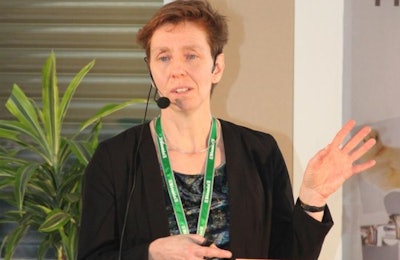
Successful antibiotic-free and reduced-antibiotic poultry production needs a holistic approach, starting with the production of high quality chicks.
All inputs and management techniques need to be carefully considered, as a mistake in one area can devalue efforts made in others, and while no feed additive alone can replace antibiotics, promising developments in additives are being made.
These were among the messages at Solving the Antibiotic-free Production Puzzle, held in Vienna, Austria, in mid-February by Biomin.
Broiler production without antibiotics reduces the freedom of the farmer, the nutritionist and the veterinarian and, to be successful, needs improved management and a stronger focus on nutrition, and must start with a good quality chick.
Strong chicks
A healthy broiler needs a healthy, good quality chick, if producers are to work without, or with only limited, antibiotics.
According to Daniel Pearson, veterinary health director with Aviagen Europe, breeding stock must be kept not only healthy but be well-managed. There needs to be good vaccination, biosecurity, water sanitation, egg cleanliness, ventilation, and water and floor egg management.
Pearson noted that over 50 percent of his time is now spent in various ways on antimicrobial-resistance that there was no sign that this would stop.
Chicken embryos must be strong, and the effects of storage need to be considered, including on hatchability and chick quality, while in ovo vaccination can reduce stress on day old chicks, he said.
Breeding companies are, among other areas, selecting for seven day liveability, with chicks having to demonstrate health and robustness.
Good nutrition
Newly-hatched chicks have an almost sterile gut, and this means that it is highly sensitive to bacterial colonization, particularly during the first seven days of life.
The need to manage this key period well is demonstrated by the fact that, for example, in The Netherlands in 2014, 18 percent of antibiotics used in broilers were used in the first two weeks of life, according to Ellen van Eerden, poultry nutrition researcher with Schorthorst Feed Research.
When thinking of the chick gut in an antibiotic-free context, it is not simply a case of replacing one additive with another to regulate the gut microflora – the entire microbial load that may challenge a bird needs to be reduced. This may be achieved through good hygiene, vaccination, feed, coccidiosis and necrotic enteritis control, feed composition, nutrients and feedstuffs.
Where nutrition is concerned, any toxic compounds must be reduced, for example, harmful metabolites, and those associated with viscous diets and protein fermentation. High viscosity due to certain NSPs will lead to more nutrients being available for bacteria, which can lead to overgrowth and protein fermentation.
It is important to remember that a normal intestinal flora benefits broiler development, boosting the immune system, providing some nutrition, excluding pathogens, and stimulating mucus production. However, it should also be remembered that bacteria also compete with the host for nutrition and while mucus secretion is beneficial, there is an energy cost.
Good management
Prevention is better than cure and farms must practice good biosecurity and good hygiene.
Biosecurity needs to be considered both in the way that farms are designed and in terms of the practices followed by the staff.
Zeno Bernardi, of Unitec, noted that when considering hygiene, there are two concepts to be kept in mind when planning – efficacy and efficiency. Will planned actions achieve result in minimal microbial prevalence, and what are the costs of achieving this goal?
Heating, ventilation, light
Heating, ventilation and light are the Bermuda Triangle of the broiler starter period, says Mark Karimi, technical sales manager Biomin, and their careful regulation will impact bird performance, irrespective of a broiler’s genetic potential.
Observing chick behavior can reveal whether chicks are being well managed, Karimi offered the example of temperature tables. While they may be a useful guide, conditions will vary from poultry house to poultry house, and so guides can only ever be of limited use. Chick behavior will reveal whether the temperature in a house is correct.
Poor ventilation can lead to variety of health issues.
Dust in poultry houses needs to be kept to a minimum. Not only can it act as a carrier for micro-organisms and endotoxins, for example, but can cause irritation, and overload lung clearance and cause lesions in the mucus membrane, for example.
High levels of dust, ammonia and CO2, if poorly managed in the early stages of broiler production might lead to far greater problems later.
Where light is concerned, if a chick cannot see it cannot eat, but a dark period is also important to ensure proper development.
Antibiotics may be man’s closest friend, he added, but we cannot expect any more from them. All inputs must be managed properly, as a failure to do so will be costly.
Comprehensive resource for antibiotic-free poultry production available
A new collection of exclusive articles, blogs, infographics and videos on antibiotic-free poultry production, by trusted WATT Global Media editors and industry experts, equip poultry producers and marketers with information to help them make critical business decisions. Purchase your copy.


















